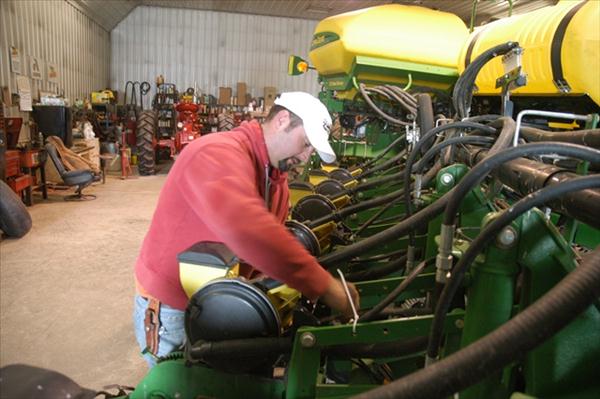April 1, 2013

I read an interesting report about corn planting from Peterson Farms Seeds, Harwood, N.D.
Adam Spelhaug, their agronomist who also writes “Dakota Crop Notes” for Dakota Farmer, says he’s noticed that a number of their top corn growers who have relatively new planters with only a few hours on them had a “disappointing number of variable corn stands” last year.
He says part of the problem appears to be planting speed.
“Our research has shown a 9.3 bushel per acre advantage over seven years from planting at speeds less than 5 mph compared to more than 5 mph,” he says.

John Horter, Andover, S.D., works on his planter in the shop in this file photo. Even top-tier corn growers are having problems setting and operating new planters, says a local seed company.
University of Wisconsin research shows yields dropped from 183 bushels per acre at 4 mph to 180 bushels per acre at 6 mph, which is a statistically significant difference. This was conducted over 12 different locations with both air and finger seed delivery systems.
Purdue agronomist Bob Nielsen studied the effect of corn stand uniformity on yield by measuring the standard deviation of the plants in plot rows. Plots with a zero deviation yielded 192.4 bushels per acre. Plots with the highest deviation, 8, had a yield of 178.5 bushels per acre. There was a 2.2 bushel per acre reduction in yield for every inch increase in standard deviation.
The plots Spelhaug looked at last spring with its Plus20 group had deviations that ranged from 0.82 to 4.11.
“We like to see at least 80% of the plants within 2-inches of the targeted spacing (6.5-inches for a 32,000 population on 30-inch rows, for example). Only half of the plots were in this range,” he says.
Spelhaug says they also found planter calibration to be a problem.
“Seven percent of the plots we looked had more than a 100% emergence rate. In other words, more plants came up than what the operator thought he was planting. This could be due to doubles, but most of these plots had low standard deviations and speeds were less than 5 mph,” he says. “It’s important to verify before you get to the field how much seed the planter is dropping. It may be different than what the book says.”
Call or email Spelhaug for more information at 866-481-7333 or [email protected]
You May Also Like




